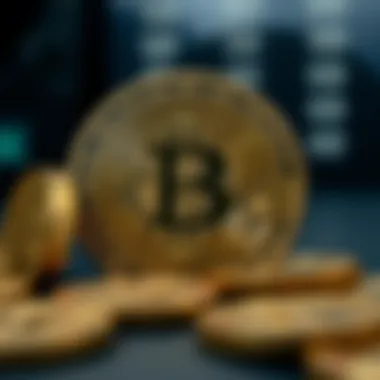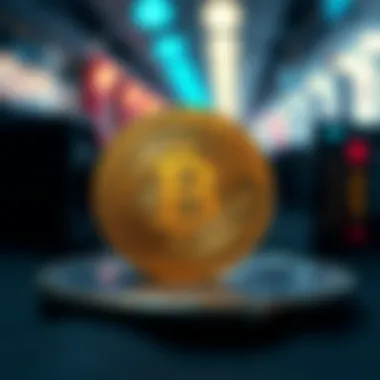A Comprehensive Guide to Buying NFTs


Intro
In an era where digital assets have taken center stage, the allure of buying non-fungible tokens, or NFTs, has gripped the imagination of both new and seasoned enthusiasts. It’s not just a trend; it’s a tidal wave reshaping the landscape of art, collectibles, and even virtual real estate. The idea of owning a unique piece of digital content has sparked curiosity and investment discussions alike. Yet, amid the excitement, the intricacies of purchasing an NFT can appear daunting.
This guide is crafted to help navigate through the labyrinth of the NFT marketplace. Expect a step-by-step rundown covering essential concepts and strategic insights to ensure you handle your investments like a pro. From choosing the right platforms to understanding the significance of digital wallets, we will dish out the key elements you need to know. We will also delve into potential hazards to watch out for and how to assess the value of these digital keepsakes effectively.
Understanding NFTs
Diving into the realm of Non-Fungible Tokens (NFTs) is like unlocking a treasure chest of digital assets that have taken the world by storm. It’s not just about art or collectibles, but about reshaping how we perceive ownership in the digital age. Understanding NFTs is crucial for anyone looking to engage in this market, whether you're a seasoned investor or new on the block. Grasping the fundamentals will provide a roadmap for the intricate landscape that is evolving rapidly.
Definition of Non-Fungible Tokens
Non-Fungible Tokens, abbreviated as NFTs, are unique digital assets that represent ownership or proof of authenticity of a specific item or piece of content on the blockchain. Unlike cryptocurrencies like Bitcoin or Ethereum, which are interchangeable and share equal value, each NFT is distinct. This uniqueness grants each token an inherent value, depending on various factors like art, music, or even virtual land. Think of NFTs as the digital equivalent of collector's items like rare baseball cards or stamps, but recorded in a way that guarantees their scarcity.
The Technical Framework of NFTs
Delving deeper into NFTs requires an understanding of their underlying technical framework. The backbone of this framework lies in blockchain technology and smart contracts, enabling the distinct characteristics of NFTs to flourish.
Blockchain Technology
Blockchain technology serves as the decentralized ledger that records all transactions involving NFTs. It offers transparency and security, as each transaction is time-stamped and immutable. This characteristic prevents any tampering, affirming the ownership of the NFT at all times. The unique aspect of blockchain lies in its ability to verify authenticity without a third party, often enhancing trust in the digital marketplace. Additionally, because NFTs are stored on various blockchains, the choice of platform impacts their accessibility and transaction speed, important considerations for potential buyers.
Smart Contracts
Smart contracts are self-executing contracts with the terms of the agreement directly written into code. They operate on the blockchain and are critical in the NFT purchase process. By automating transactions and ensuring all conditions are met before execution, they enhance reliability and fairness. The key advantage here is that these contracts eliminate the need for intermediaries, reducing fees and expediting transfers. Yet, one must tread carefully, as the coding errors can lead to vulnerabilities, compromising the transaction.
Uniqueness and Ownership
The defining attribute of NFTs is their uniqueness and ownership. Each NFT is tied to its specific metadata and cannot be duplicated, making it critical for collectors and artists. This uniqueness means NFTs can embody a sense of pride for ownership that traditional assets sometimes lack. Additionally, ownership is verifiable through the blockchain, ensuring authenticity. However, as appealing as this might sound, it’s essential to recognize the risks involved; proving ownership doesn't inherently guarantee the lasting value of the asset. The fluctuating demand in the market can greatly affect perceived worth.
"Understanding NFTs isn’t merely about collecting; it’s about comprehending a new frontier of ownership and creativity in an increasingly digital world."
Grasping these foundational elements is essential to prepare for engaging in the NFT market. Knowledge breeds confidence, enabling informed decisions and strategic investments.
Prerequisites for Purchasing NFTs
Before diving headfirst into the colorful world of non-fungible tokens (NFTs), there’s a clear path you need to tread, laden with certain prerequisites. Understanding these elements is not just beneficial but fundamental for making educated purchases that align with your digital ambitions. This part of the article lays down the groundwork necessary to navigate the NFT landscape effectively.
Understanding Cryptocurrency
Types of Cryptocurrencies Used
When embarking on your NFT journey, the very first step usually involves diving into the cryptocurrency realm. Not all cryptocurrencies are created equal, but a few dominate this digital marketplace. Ethereum is perhaps the heavyweight champion in this card game—it's the backbone of many NFT transactions.
- Key characteristic: Ethereum's smart contract functionality allows artists and developers to create unique tokens that represent their digital assets.
- Why is it popular? This flexibility makes Ethereum the preferred choice for many creators in the NFT space.
- Unique feature: Besides Ethereum, cryptocurrencies like Binance Smart Chain and Flow are also gaining traction, appealing for their lower transaction costs.
However, one must note that while these emerging tokens offer potential advantages like lower fees, they may lack the vast ecosystem and community support that Ethereum boasts.
Converting Fiat to Crypto
Having your cryptocurrency in hand is crucial, and the process of converting fiat money (like dollars or euros) into cryptocurrency is often the bridge toward purchasing NFTs. This isn't just important; it's a necessary step for most new entrants.


- Key characteristic: Platforms like Coinbase and Kraken provide simple interfaces for buyers to convert their traditional currency into cryptocurrency.
- Why is it beneficial? This process opens the door for a broader audience, allowing anyone with a bank account to start their NFT adventure.
- Unique feature: The transaction speed and transparency in this conversion process make it easier for newcomers to jump into the market. However, it is essential to keep an eye on fees that come along with these conversions; they can sometimes nibble away at your funds, especially when it wasn't anticipated.
Setting Up a Digital Wallet
Types of Wallets (Hot vs. Cold)
A digital wallet is the digital equivalent of your purse or wallet, only it's where you store your cryptocurrencies and NFTs. The choice between hot wallets and cold wallets can significantly affect your NFT purchasing experience.
- Key characteristic: Hot wallets are often online or connected to the internet, making them convenient for quick trades.
- Why are they popular? They let users manage transactions efficiently and access them immediately.
- Unique feature: Cold wallets, on the other hand, are offline, providing enhanced security for your assets against potential hacks. While they’re slower for transactions, they're seen as safer—especially for long-term investors.
In this case, your choice boils down to convenience versus security, with a balanced approach often being the best bet.
Security Considerations
Security should always be top of mind in the crypto world, especially with the rising number of scams and hacks. Understanding the security landscape is vital for protecting your valuable NFTs and cryptocurrencies.
- Key characteristic: Two-factor authentication (2FA) is a must when you start handling digital assets.
- Why is it important? It adds a crucial layer of security to prevent unauthorized access.
- Unique feature: Regular updates and using trustworthy wallet services ensure that your assets stay protected from emerging threats.
While the security measures might seem tedious, they play a crucial role in maintaining peace of mind as you navigate this sometimes treacherous digital terrain.
"Investing in NFTs is like walking a tightrope; a strong foundation is your safety net against unpredictable falls."
By understanding these prerequisites, you will feel more comfortable as you make your way into NFT purchases, laying a strong groundwork for any future endeavors in the digital marketplace.
Navigating NFT Marketplaces
The world of NFTs can be a bit like trying to find a needle in a haystack, especially with so many marketplaces popping up. Understanding how to navigate these platforms is crucial for anyone looking to purchase non-fungible tokens. Each marketplace comes with its own unique set of features, characteristics, and user experiences which can greatly influence your buying decision. Getting acquainted with these marketplaces makes the buying process smoother and more informed.
Popular NFT Marketplaces Overview
There are a few standout marketplaces that have gained significant traction in the NFT community. Each brings something different to the table.
OpenSea
OpenSea is often considered the biggest fish in the pond when it comes to NFT marketplaces. It boasts a staggering range of assets from art to collectibles, which can cater to various tastes. What makes OpenSea particularly appealing is its user-friendly interface that lets even the most technologically challenged navigate the waters with relative ease. One unique feature is its
Buying Process Step-by-Step
In the perplexing realm of NFTs, understanding the buying process becomes pivotal. Getting your feet wet involves deciphering how to locate the digital gems worth your investment and knowing how to make a purchase without a hitch. The process might seem daunting at first glance, but breaking it down step-by-step can significantly diminish the uncertainty. This section will guide you through the essentials of finding NFTs and how to make an acquisition, ensuring you embark on this investment journey with clarity.
Finding NFTs to Purchase
Finding the right NFT can be like looking for a needle in a haystack, given the sheer volume of choices available nowadays. However, target a few specific areas to maximize both your enjoyment and potential for growth. Three key categories stand out: Art and Collectibles, In-Game Assets, and Virtual Real Estate.
Art and Collectibles
Art and collectibles are arguably the show-stoppers in the NFT space. These digital artworks often hold significant emotional and financial value, attracting both artists and collectors alike. A key characteristic of this category is its connection to cultural moments, often reflecting current trends and societal shifts.
The unique feature of art NFTs lies in their authenticity and ownership verification tied to blockchain technology. This means that when you buy an artwork, not only do you own a piece of digital creativity, but you are also assured of its provenance.
Yet, it’s crucial to exercise caution. The market is littered with a variety of styles and formats, some more appealing than others, and price points can vary widely. While the market for digital art is booming, be wise. Always verify artists’ credibility and assess your own emotional attachment to the piece before making a purchase.
In-Game Assets
In the gaming world, in-game assets have taken the NFT scene by storm. Players can buy unique items—such as skins, weapons, or avatars—that can enhance their gaming experience. The major appeal here is the ability to transfer and own assets across different games or platforms, thanks to blockchain technology.


This type of NFT can be particularly popular among younger audiences, as they not only provide cosmetic alterations but can also influence gameplay. However, the caveat is that the value of these assets can fluctuate wildly based on game popularity and player demand. Thus, while investing in in-game assets can yield significant returns, these purchases should align with your gaming habits and long-term commitment to the game.
Virtual Real Estate
The concept of virtual real estate might sound peculiar but offers a fascinating investment avenue. It includes parcels in digital lands of platforms like Decentraland or The Sandbox. Investors buy, trade, or even develop this virtual land just like physical properties. This category's standout feature is its blending of traditional property investment principles with a digital twist.
Owning virtual land can be beneficial as it may appreciate over time, especially as more users flock to the metaverse. However, the market is still relatively new, and potential investors must wrestle with uncertainties regarding location, potential developments, and overall market growth. Do your due diligence before diving headfirst into this futuristic concept.
Placing a Bid or Buying Outright
Once you have found the NFTs that pique your interest, the next step is deciding how to purchase them. There are primarily two avenues: placing a bid in an auction or buying them outright at a fixed price.
Auction Mechanics
Auction mechanics add a level of excitement to NFT buying, akin to a treasure hunt. When you participate in an auction, you’re not just a buyer; you’re competing against others who might also be admiring the same piece.
The essence of this method lies in its dynamic pricing. A key characteristic is the potential to acquire NFTs at lower prices than their market value through savvy bidding. However, this method has its own set of challenges. The excitement can lead to emotional decisions—resulting in overbidding. Only pursue auctions if you can maintain discretion and stick within your financial limits.
Fixed Price Listings
On the contrary, fixed price listings offer a sensible alternative for investors seeking a more straightforward shopping experience. The idea is simple: you see a price, and if it suits your budget, you simply make the purchase. This format is advantageous for individuals who prefer clarity over competition.
Unlike auctions, where prices can be unpredictable, fixed listings provide a clearer path for your financial commitments. But there’s a catch: some of the most sought-after NFTs might be listed at inflated prices, and there may be room for negotiation depending on the marketplace platform. Hence, do consider researching similar NFTs’ prices before making a snap decision.
In summary, navigating through the buying process step-by-step allows for valuable engagement with potential investments in the ever-evolving NFT landscape.
Post-Purchase Considerations
Understanding what to do after purchasing an NFT is just as vital as the acquisition process itself. The NFT market can be wild, and what you decide to do next can impact your investment's worth and your overall experience. This phase includes managing your collection, evaluating its long-term value, and being aware of potential risks. Effective management can enhance your ownership experience while safeguarding your assets.
Managing Your NFT Collection
Managing your NFT collection is about more than just having ownership; it’s about cultivation.
Displaying NFTs
Displaying NFTs is a crucial aspect that transforms them from simple digital items to pieces of art or collectibles. Many collectors choose to showcase their assets through virtual galleries or platforms that offer interactive displays. This practice not only celebrates the art but can also enhance its perceived value. Imagine walking through a virtual space where each digital painting sparks conversation and admiration.
The key selling point of displaying NFTs is the community aspect it brings. It connects you with fellow enthusiasts, allowing for collaboration and networking. However, it's not without its drawbacks. Not all virtual displays offer the same security features, and a poor selection of platforms could lead to unauthorized use or low visual fidelity.
Transferring Ownership
Transferring ownership is another significant topic when managing your NFT collection. When you decide to sell or gift an NFT, the process should be seamless and secure. The unique aspect of NFTs is that the ownership can be transferred on the blockchain, ensuring that the record is immutable and transparent. For potential buyers, knowing that they are getting something authentic boosts confidence in the purchase.
Despite its importance, transferring ownership can also have its downsides. If not executed properly, transaction fees may rack up quickly, especially during periods of high blockchain activity. Additionally, the intricacies of smart contracts can confuse less experienced users, possibly leading to unintended consequences for sellers or buyers alike.
Ensuring Provenance
Keeping track of NFT provenance is like having an art history background for your digital art; it tells the story, tracks the value, and lends credibility. Provenance refers to the history of ownership and transactions associated with an NFT. It is a vital aspect that greatly impacts an asset's value. Potential buyers want to know if they are purchasing a well-regarded piece with a reputable history or something less illustrious.
This aspect is valuable for collectors because it can make or break potential investments. A strong provenance can lead to increased demand and higher prices, while a questionable history can deter buyers. Nevertheless, interpreting provenance can be a double-edged sword; some users may find it challenging to navigate through extensive historical data, and mistakes in record-keeping could likewise mislead buyers.


Evaluating Long-Term Value
Evaluating long-term value involves looking beyond immediate market trends to understand an NFT's potential sustainability and demand over time. In a vibrant market, this involves digging deeper into various factors that influence how well an asset might hold its weight.
Market Trends and Demand
Market trends and demand serve as a barometer for valuing NFTs. Interested collectors should be aware of what’s hot and what’s not. By keeping an eye on what types of NFTs are in demand—be it digital art, music, or virtual real estate—you can assess which ones might appreciate more over time.
This focus on trends can reveal rewarding opportunities, but there’s a caveat. Trends can be fleeting and sales can fluctuate wildly. Just because something is in vogue today doesn’t guarantee its value tomorrow. Therefore, a balanced strategy that combines trend analysis with a focus on quality and personal taste is wise.
Rarity and Scarcity Factors
Rarity and scarcity serve as crucial elements in determining an NFT's value. The idea is simple; the fewer there are of something, the more valuable it becomes to a collector. Unique pieces or limited editions often fetch high prices. Collectors should scrutinize how many copies exist, the artist's reputation, and whether scarcity is artificially manufactured or genuine.
A central benefit here is that rarity can provide a cushion against market volatility. In many cases, scarce items can be resistant to drastic drops in demand. However, the trade-off lies in higher initial costs, and determining what makes an NFT rare versus simply overhyped can become a complex endeavor.
Risks and Challenges in NFT Acquisition
Engaging in the acquisition of non-fungible tokens (NFTs) carries its share of unpredictable waters. While the market has exploded with potential and creativity, an equally important aspect must be examined: the risks and challenges associated with NFT investments. This section elucidates why understanding these risks is vital for both new and seasoned investors, helping them navigate the NFT landscape with a sharper awareness.
NFTs can be enticing, but like any investment strategy, they come with uncertainties. One must consider fluctuating market trends and evolving technologies. A comprehensive grasp of potential pitfalls can differentiate a savvy investor from someone simply caught up in the hype.
Market Volatility
Just as the tides change, so does the NFT market. The market volatility that surrounds NFTs can be dramatic and unpredictable. Prices can soar one day and crash the next. Investors need to realize that what’s popular today might not hold the same value tomorrow.
- Historical Price Fluctuations: For example, art pieces that sold for millions just a year ago may now struggle to attract half that amount. This is a classic testament to the hyper-speculative nature of NFTs.
- Limited Historical Data: As a relatively new class of assets, NFTs lack robust historical analysis for predicting market movements effectively. Many investors get swept away as they watch bidding wars escalate but overlook the long-term sustainability of this trend.
"The only constant in the NFT market is change. You either adapt or risk losing a lot."
Additionally, one must factor in the emotional rollercoaster involved. As values rise and fall, emotions can overtake rational investment decisions. Therefore, a clear strategy and unwavering discipline become essential. Investing in NFTs isn’t just about buying; it’s about being prepared to weather the storm of market fluctuations.
Counterfeit NFTs and Fraud
The digital landscape, despite its wonders, also harbors its share of nefarious activity. Counterfeit NFTs and fraud present significant barriers that potential investors should not ignore. Scams can take many forms, from fake collections to the impersonation of well-known artists.
- Identifying Fakes: Many rely on third-party verification to ensure authenticity, yet fraudulent campaigns manage to slip through, leading to significant financial loss. Being vigilant is crucial. Always check the creator’s profile and transaction history.
- Scam Tactics: Phishing schemes are also prevalent, where scammers aim to steal digital wallets by tricking users into revealing sensitive information. Secure any credentials and remember — if it seems too good to be true, it likely is.
A thorough investigation of the NFT’s provenance, understanding the artist’s brand, and maintaining skepticism towards exceptionally low prices can shield you from falling prey to scammers. Here, communities play a pivotal role; engaging with fellow traders or collectors on platforms like Reddit can offer insights and alerts on potential fraudulent activities.
In summary, while the allure of NFTs can be compelling, a proactive approach to understanding the risks and challenges can significantly enhance your investment journey. As you dive into the vibrant world of NFTs, staying informed and cautious can prepare you for both opportunities and obstacles that may arise.
Epilogue
Recap of Key Points
Let's take a step back and recap the crucial concepts that we’ve discussed:
- Understanding NFTs: NFTs are digital assets that represent ownership of unique items, made possible by blockchain technology. Each token is distinct and cannot be exchanged on a one-for-one basis, reinforcing their individuality.
- Prerequisites for Purchase: Knowledge of cryptocurrency is essential, along with setting up a digital wallet. This step is foundational for safely storing and managing your digital assets.
- Navigating Marketplaces: Familiarizing yourself with popular NFT marketplaces like OpenSea and Rarible helps in finding potential purchases while understanding the specific features, transaction fees, and community support available.
- Buying Process: From identifying your desired NFTs to understanding auction mechanics, the buying process is crucial in ensuring you acquire the right tokens at the right price.
- Post-Purchase Management: After acquiring NFTs, managing your collection and understanding factors that affect long-term value are essential for making informed decisions.
- Risks Involved: Awareness of market volatility and counterfeit risks prepares you to navigate challenges that could impact your investments.
This recap underlines the complexities involved and emphasizes that diligence and understanding are key.
Future of NFTs
The future of NFTs seems as dynamic as a paint palette in a sprightly artist's hands. With ongoing advancements in technology and the growing acceptance of digital assets, the NFT landscape is set for evolution. We might witness:
- Mainstream Adoption: As the technology matures, more brands and industries could embrace NFTs, integrating them into their ecosystems. This includes everything from music and gaming to real estate.
- Interoperability: Future developments may allow NFTs to move seamlessly across different platforms and blockchains, enhancing functionality and value.
- Environmental Considerations: The environmental impact of blockchain technology is gaining scrutiny. Consequently, greener alternatives could emerge, making NFT transactions more sustainable.
- Regulatory Developments: As more individuals and entities engage with NFTs, it’s likely that regulatory frameworks will be established, aiming to protect consumers while fostering innovation.



